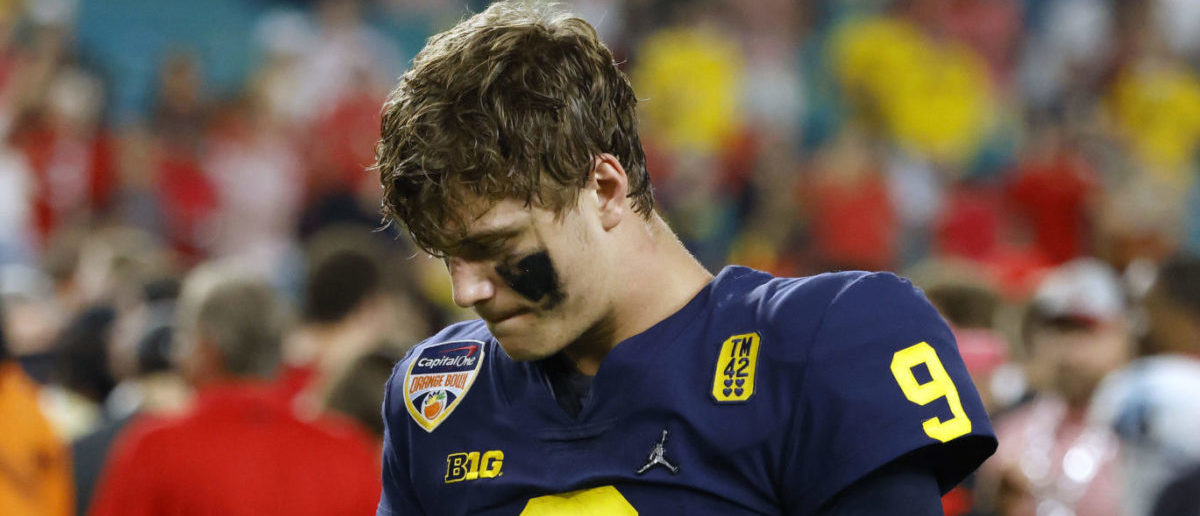JJ McCarthy’s Injury and Recovery

JJ McCarthy, the talented quarterback for the University of Michigan Wolverines, sustained a significant knee injury during the 2023 season, prompting concerns about his immediate future and long-term prospects. The injury, which required surgery, has understandably raised questions about the nature of the injury, the specific surgical procedure performed, and the anticipated recovery timeline.
The Nature of the Injury
JJ McCarthy suffered a torn ACL (anterior cruciate ligament) in his left knee. The ACL is a vital ligament that helps stabilize the knee joint, preventing excessive forward movement of the tibia (shinbone) relative to the femur (thighbone). A torn ACL is a common injury in athletes, particularly those involved in sports that require sudden changes in direction, pivoting, and jumping.
The Circumstances of the Injury
The injury occurred during the Wolverines’ game against the Penn State Nittany Lions on October 21, 2023. While attempting to make a tackle, McCarthy landed awkwardly on his left leg, causing the ACL tear.
The Surgical Procedure
Following the injury, McCarthy underwent surgery to repair the torn ACL. The specific procedure involved reconstructing the ligament using a graft, typically taken from another part of the body, such as the patellar tendon, hamstring tendon, or quadriceps tendon. The graft is then secured to the bone using screws or other fixation devices.
Expected Recovery Timeline
The recovery process for an ACL tear and reconstruction can vary depending on several factors, including the individual’s age, overall health, and the severity of the injury. However, a typical recovery timeline for an ACL reconstruction is approximately 9-12 months.
Rehabilitation Process
The rehabilitation process for an ACL reconstruction is crucial for restoring full function to the knee. It typically involves a structured program that progresses through various stages:
- Initial Stage: This stage focuses on reducing pain and swelling, improving range of motion, and regaining strength in the quadriceps and hamstring muscles. It may involve crutches, immobilization, and gentle exercises.
- Intermediate Stage: As the knee heals, the focus shifts to regaining balance, coordination, and proprioception (the ability to sense the position of the knee joint). This stage may include exercises such as walking, jogging, and light plyometrics.
- Advanced Stage: The final stage involves strengthening and conditioning the knee, preparing for return to sport. This stage may involve more advanced plyometrics, agility drills, and sport-specific exercises.
Impact on McCarthy’s Career: Jj Mccarthy Knee Surgery

JJ McCarthy’s knee surgery could significantly impact his upcoming season and his long-term career prospects. While the extent of the impact will depend on the severity of the injury and the effectiveness of the rehabilitation process, it’s crucial to analyze the potential consequences and strategies to mitigate them.
Potential Impact on the Upcoming Season
The knee injury could significantly affect McCarthy’s performance in the upcoming season. The recovery process from knee surgery can be lengthy and arduous, requiring significant time and effort for rehabilitation. During this time, McCarthy may experience limitations in his mobility, agility, and overall athleticism, potentially impacting his ability to perform at his pre-injury level.
For instance, a similar injury to former NFL quarterback Tom Brady in 2008 sidelined him for a significant portion of the season. Brady, known for his mobility and agility, had to adjust his playing style and rely more on his arm strength, impacting his performance. McCarthy might face a similar challenge, requiring him to adapt his game to compensate for any limitations caused by the injury.
Comparison to Pre-Injury Performance, Jj mccarthy knee surgery
Prior to the injury, McCarthy was a dynamic and promising quarterback, demonstrating impressive athleticism, accuracy, and playmaking ability. His ability to extend plays and make throws on the run was a key asset to his game. However, the knee surgery could potentially affect these abilities, impacting his overall performance.
For example, if McCarthy’s mobility is restricted, he might be forced to make decisions quicker, potentially leading to more interceptions or inaccurate throws. Additionally, he might have to rely more on his arm strength and accuracy, which could be affected by the injury’s impact on his throwing mechanics.
Potential Impact on Long-Term Career Prospects
The impact of the injury on McCarthy’s long-term career prospects depends on the severity of the injury and his ability to fully recover. While a well-executed rehabilitation program can significantly improve the chances of a successful recovery, the injury could potentially affect his durability and longevity in the sport.
For example, if the injury results in recurring issues or limits his athleticism, it could impact his ability to play at a high level for an extended period. However, with proper care and rehabilitation, McCarthy could potentially overcome these challenges and continue his career successfully.
Strategies to Mitigate the Impact of the Injury
McCarthy and his team can implement several strategies to mitigate the impact of the injury and ensure a successful recovery. This includes:
- Dedicated Rehabilitation: McCarthy needs to dedicate himself to a comprehensive rehabilitation program, focusing on strengthening his knee, regaining mobility, and improving his overall athleticism.
- Adjusting Playing Style: McCarthy and his coaches might have to adjust his playing style to minimize the stress on his knee, relying more on his arm strength and accuracy while limiting his mobility.
- Building Strength and Conditioning: A focus on building strength and conditioning, particularly in the lower body, will help McCarthy regain his explosiveness and minimize the risk of re-injury.
- Mental Preparation: It’s crucial for McCarthy to maintain a positive mindset and focus on the rehabilitation process. This involves setting realistic goals, staying motivated, and seeking support from his team and medical staff.
Knee Injuries in Athletes

Knee injuries are common among athletes, particularly in sports that involve running, jumping, and pivoting. These injuries can range from minor sprains to serious ligament tears, and can significantly impact an athlete’s performance and career.
Types of Knee Injuries
Knee injuries are categorized based on the affected structures.
- Ligament Injuries: Ligaments are strong, fibrous tissues that connect bones. Injuries to these ligaments, such as sprains or tears, are common in athletes. The most common ligament injuries include:
- Anterior Cruciate Ligament (ACL) Tear: This injury often occurs during sudden pivoting or landing with a hyperextended knee. It can cause instability in the knee joint.
- Posterior Cruciate Ligament (PCL) Tear: This injury usually happens when a direct force is applied to the front of the knee, causing the tibia to slide backward.
- Medial Collateral Ligament (MCL) Tear: This injury occurs when a force is applied to the outside of the knee, causing the knee to bend inward.
- Lateral Collateral Ligament (LCL) Tear: This injury happens when a force is applied to the inside of the knee, causing the knee to bend outward.
- Meniscus Tears: The menisci are C-shaped pieces of cartilage that act as shock absorbers in the knee joint. Tears in these structures can occur during twisting or pivoting movements.
- Tendon Injuries: Tendons connect muscles to bones. Injuries to the tendons around the knee, such as the patellar tendon or the hamstring tendons, can cause pain and weakness.
- Patellofemoral Pain Syndrome: This condition involves pain in the front of the knee, often caused by overuse or improper biomechanics.
- Osteochondral Defects: These injuries involve damage to the cartilage and underlying bone in the knee joint.
Treatment Options
Treatment options for knee injuries vary depending on the severity of the injury.
- Non-Surgical Treatment: This may include rest, ice, compression, and elevation (RICE), pain medication, physical therapy, and bracing.
- Surgical Treatment: Surgery may be necessary for severe ligament tears, meniscus tears, or osteochondral defects. Surgical procedures can involve repairing or reconstructing the damaged structures.
Long-Term Effects
Knee injuries can have significant long-term effects on athletic performance.
- Decreased Range of Motion: Scarring and stiffness can limit knee movement.
- Instability: Ligament injuries can cause instability in the knee joint, making it difficult to perform certain movements.
- Pain: Chronic pain can limit activity and affect overall well-being.
- Increased Risk of Re-Injury: Athletes who have experienced a knee injury are at a higher risk of re-injury.
- Early Retirement: In some cases, severe knee injuries can force athletes to retire early.
Jj mccarthy knee surgery – JJ McCarthy’s knee surgery was a tough blow, but he’s already making strides in his recovery. You can stay up-to-date on his progress and other news about his career by checking out jj mccarthy news. It’s clear that JJ is a dedicated athlete, and we’re all rooting for his return to the field.
JJ McCarthy’s knee surgery has been a hot topic, especially for Minnesota fans hoping for a strong season. With the Vikings’ recent history, they’re always looking for a solid vikings qb to lead them to victory. Hopefully, McCarthy’s recovery goes smoothly and he can contribute to the Vikings’ success this year.
